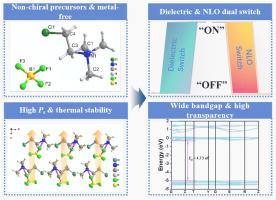Wide-bandgap molecular ferroelectric with thermally switchable dielectric and NLO responses from non-chiral design
IF 4.7
2区 化学
Q2 CHEMISTRY, PHYSICAL
引用次数: 0
Abstract
Molecular ferroelectrics that combine switchable dielectric and nonlinear optical (NLO) properties hold great promise for next-generation flexible and wearable optoelectronic devices. However, their development is often hindered by the reliance on expensive chiral precursors and limited thin-film processability. In this study, we report the rational design of a flexible organic molecular ferroelectric, chloroethyltrimethylammonium fluoroborate ([CETMA][BF₄]), using low-cost non-chiral precursors and a fluoroborate anion strategy. This compound features a wide bandgap of 4.73 eV and undergoes a thermally reversible first-order phase transition at 352 K (ΔS = 21.83 J mol⁻¹ K⁻¹), enabling dual switching of both dielectric and NLO responses. The transition involves symmetry breaking between the polar phase Cmc2₁ (SHG response: 0.5×KDP; dielectric constant ε′ = 5) and the centrosymmetric phase P6₃/mmc (SHG: 0; ε′ = 10), accompanied by broad optical transparency across the 300–2500 nm range. The material exhibits a notable spontaneous polarization (Pₛ) of 17.57 μC/cm² and demonstrates a superior combination of wide bandgap and high transparency, outperforming many classical ferroelectric materials. This work provides a feasible design strategy for developing high-performance metal-free ferroelectrics with enhanced integrability and functionality for modern optoelectronic applications.

非手性设计的具有热可开关介电和NLO响应的宽带隙分子铁电材料
结合可切换介电和非线性光学(NLO)特性的分子铁电体在下一代柔性和可穿戴光电器件中具有很大的前景。然而,它们的发展往往受到依赖昂贵的手性前驱体和有限的薄膜可加工性的阻碍。在这项研究中,我们报道了一个柔性的有机分子铁电,氯乙基三甲基氟硼酸铵([CETMA][BF₄])的合理设计,使用低成本的非手性前驱体和氟硼酸阴离子策略。该化合物具有4.73 eV的宽带隙,并在352 K (ΔS = 21.83 J mol⁻¹K⁻¹)下经历热可逆的一阶相变,从而实现介电和NLO反应的双重切换。这种转变涉及极性相Cmc2₁(SHG响应:0.5×KDP;介电常数ε ' = 5)和中心对称相P6₃/mmc (SHG: 0; ε ' = 10)之间的对称破断,伴随着300 - 2500nm范围内的宽光学透明度。该材料具有17.57 μC/cm²的自发极化(Pₛ),具有宽禁带和高透明度的优异性能,优于许多经典铁电材料。这项工作为开发高性能无金属铁电体提供了一种可行的设计策略,具有增强的可集成性和功能,可用于现代光电应用。
本文章由计算机程序翻译,如有差异,请以英文原文为准。
求助全文
约1分钟内获得全文
求助全文
来源期刊

Journal of Molecular Structure
化学-物理化学
CiteScore
7.10
自引率
15.80%
发文量
2384
审稿时长
45 days
期刊介绍:
The Journal of Molecular Structure is dedicated to the publication of full-length articles and review papers, providing important new structural information on all types of chemical species including:
• Stable and unstable molecules in all types of environments (vapour, molecular beam, liquid, solution, liquid crystal, solid state, matrix-isolated, surface-absorbed etc.)
• Chemical intermediates
• Molecules in excited states
• Biological molecules
• Polymers.
The methods used may include any combination of spectroscopic and non-spectroscopic techniques, for example:
• Infrared spectroscopy (mid, far, near)
• Raman spectroscopy and non-linear Raman methods (CARS, etc.)
• Electronic absorption spectroscopy
• Optical rotatory dispersion and circular dichroism
• Fluorescence and phosphorescence techniques
• Electron spectroscopies (PES, XPS), EXAFS, etc.
• Microwave spectroscopy
• Electron diffraction
• NMR and ESR spectroscopies
• Mössbauer spectroscopy
• X-ray crystallography
• Charge Density Analyses
• Computational Studies (supplementing experimental methods)
We encourage publications combining theoretical and experimental approaches. The structural insights gained by the studies should be correlated with the properties, activity and/ or reactivity of the molecule under investigation and the relevance of this molecule and its implications should be discussed.
 求助内容:
求助内容: 应助结果提醒方式:
应助结果提醒方式:


